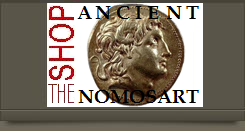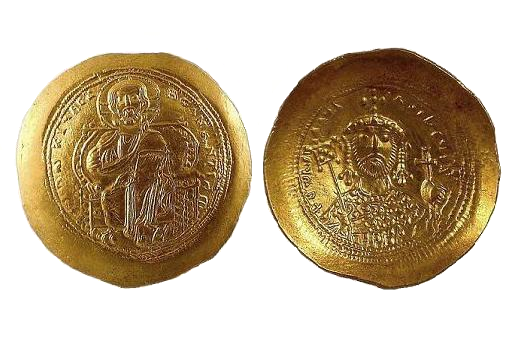
about ancient nomos
Ancient Nomos Art is a museum of galleries exhibiting ancient coins and ancient mint maps. The coin gallery displays the diverse art and history of hand-crafted ancient Greek, Roman, Byzantine, Persian and Medieval coinage. The ancient mints mapping gallery features Greek, Roman, Byzantine, Asia Minor and Medieval mint city regions and territories. Visitor's are welcome to explore, study and enjoy Ancient Nomos Art.

Byzantine, Roman – 1042 AD
Constantine IX
From Ancient Galleries

Obverse: Christ seated on lyre-backed throne facing forward, nimbate, right hand in sling raised in benediction with book of Gospels in left hand; triple bead border.
Reverse: Constantine wearing crown, loros, holding labarum and globus cruciger.
LEGEND
Obv: +IhS XIS RЄX RЄζNANTIηM; Nimbate Christ seated facing on lyre-backed throne, wearing nimbus cruciger, pallium and colobium, right arm in sling with hand raised in benediction and holding the book of Gospels in left hand. Triple border of dots. Rev: +CωhST AηTη bASILЄu Rm; Bust of Emperor facing, bearded, wearing crown, saccos and jeweled loros, he holds labarum over right shoulder at angle and raised globus cruciger in left hand. Triple border of dots.
Constantine IX Monomachus reigned as Byzantine Emperor from 1042-1054 AD. He was the son of Theodosios Monomachus, a respected member of the Basil II administation. Following Michael IV death, Constantine IX became the 3rd candidate to be widow Zoë’s 3rd husband, ironically, while he was still in exile for conspiring against Zoë. Upon return from exile, he agreed to marry Zoë and assume a role as co-emperors in 1042 AD. The gold coinage of Constantine IX reflects the Byzantine tradition of displaying Christian symbols and icons. The obverse image is the forward facing Christ Pantocrator wearing the pallium, colobium and nimbus cruciger vestments. His right arm rests in a sling with right hand raised in benediction. His left hand is holding the book of Gospels. The reverse image depicts the Emperor himself wearing a jeweled loros while holding a tendril ornamented cross labarum over his right shoulder. His left hand raises the globus surmounted with a patriarchal double cross. The Emperor’s image on this coin closely resembles the famous art tile mosaic portrait of the Emperor found on the east wall in the Hagia Sophia Church. A unique feature of late Byzantine coinage is the concave obverse and convex reverse surfaces. The resulting shape is termed scyphate or nummi scyphati to describe its “cup” like appearance. Some suggested that perhaps two sets of curved dies were used to strike each coin. The first slightly curved die pairings were thought to strike an initial bowl shaped flan, while a second die pairing, with greater periphery curvature and engraving, struck the final form and images to achieve the scyphati coinage.
DOCUMENTATION
Value: Histamenon. Metal:AV Gold. Weight: 4.42 grams. Mint: Constantinople. Date:1042-1055AD
Attribution: Dumbarton Oaks Collection, III 2a; Sear, Byzantine Coins 1829; Berk 300B; NAC 29.
Legend, Documentation and Attribution
